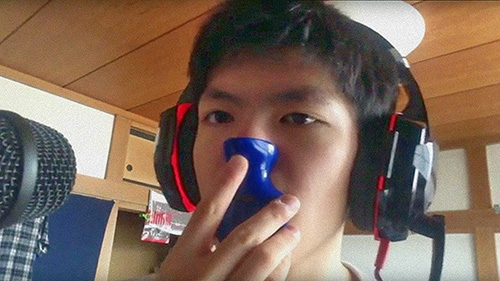
Why do people love the nose flute ?
1. - it is very funny and spreads the fun
2. - it is easy to play, at least at the beginning
3. - it is very affordable, democratic and humble
4. - it is small and you can carry one everywhere
5. - it leaves the hands free to play along another instrument
6. - it is rather unknown, so it always provoke awe
7. - it can be made with many materials, many shapes, even be a sculpture
8. - it is able to serve many uses: music, bird calling, signals, etc.
9. - it is always an appreciated gift
10.- it is regarded as a healing tool, for body and soul, as using nasal breath
11.- it is an achromatic instrument, open to any mode and ready for glissandi!
Why do people hate the nose flute ?
1. - it is disgusting to blow with the nose
2. - it is not an instrument but a toy
3. - it makes you look stupid or dangerous
4. - it is an achromatic instrument, it sounds out of tune!
----
Now, can we deal with the four negative points?
1. - it is disgusting to blow with the nose
A nose flute is not disgusting as far as the player is not disgusting.
Would you say the beak flute is disgusting? Well, there are much more nasty bacterias in the mouth than in the nose. So, as far as you (normally) blow your nose and you pass sometimes your nose flute under the tap, it is far less disgusting than a trumpet or a keyboard. Do our detractors regularly clean their cell phone with alcohol ? Because a cell phone retains more (and more dangerous) bacterias than a toilet seat.
Oklahoma State university study claims:

2. - it is not an instrument but a toy
The nose flute is toy? Well, all depends on what you do with! If you use your Steinway piano as a bobsleigh, it becomes a bobsleigh. Ask Master Mosurin if he thinks the nose flute is not a real instrument! No, seriously. Well, there are toy nose flutes. The common plastic Humanatone is not made for playing the aria of the Queen of the Night. But nobody says that the piano is not an instrument because you can find some plastic models for kids in the toys stores!
The Nosy Diva playing Bach's Badinerie at Michaeliskirche for Summer concert (F. Graser):

3. - it makes you look stupid or dangerous
Looking stupid or dangerous... This is the most difficult point to refute. But let's just say that this very point could be applied to many other instruments, and that nobody never point it out. Have you seen Dizzy Gillespie playing his trumpet with cheeks ready to explode? Has someone ever said that trumpet is ridiculous because of that? Have you seen the painful and pathetic faces of some classical musicians while playing? Or rock guitarists looking like having an orgasm while playing a solo ? Nobody mock at them, because it's part of their art.
The great Dizzy Gillespie:

4. - it is an achromatic instrument, it sounds out of tune!
Once again, if a nose flute sounds out of tune, the responsible may be not the instrument... Anyway, yes, the musical saw, the kazoo, the Theremin, the syringe whistle ... all are despised. So, if the reason is the 'achromaticity', why not the violin or the ud ? Because, besides people really bad at playing violin, there are masters... OK. Nose flute too! Listen to Mosurin or the Nosy Diva, listen to Mr. Swing or Lloyd Buford Threlkel! Well, this argument doesn't stand for a second. Yes, nose flute is difficult to master. Like any great and versatile instrument. And 'portamento compatibility' is a power, not a flaw.
Slide is freedom! (ask Tony Hawk!)

----
But after this four-points speech for the defense, some people will continue to say « yes, but no. » meaning « yes, you're probably right, but it's stronger than me, a nose flute is a disgusting crappy toy that just can be valuable as washing powder gift and used once for carnival when you're totally drunk ». I can't reply to those, they just are brain formatted and too coward to experiment opening their mind, too risky. On social and political fields, the same are racists and fascists. Better not count them in our nosy circles.





























